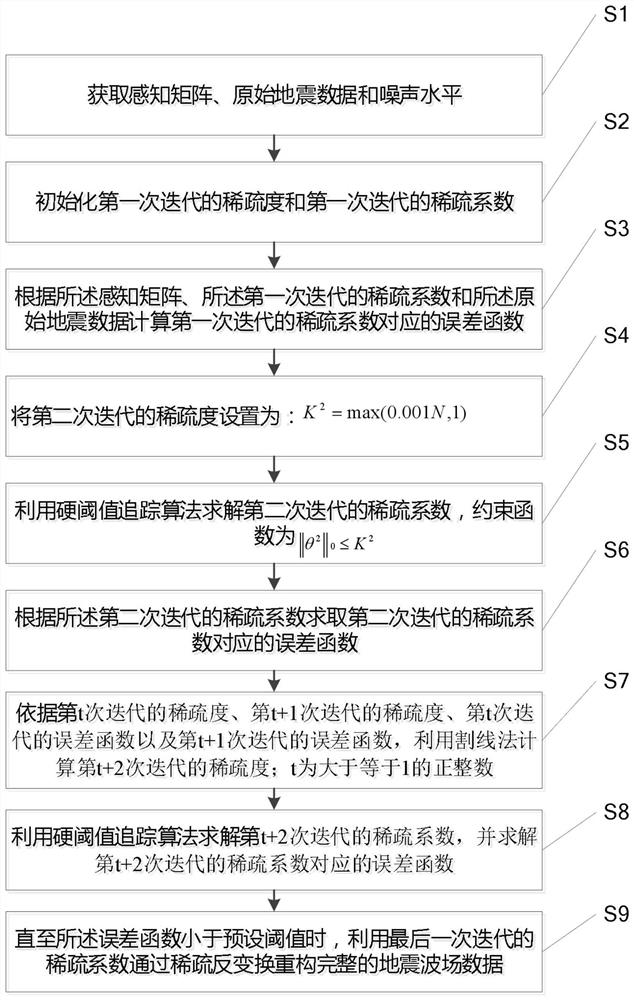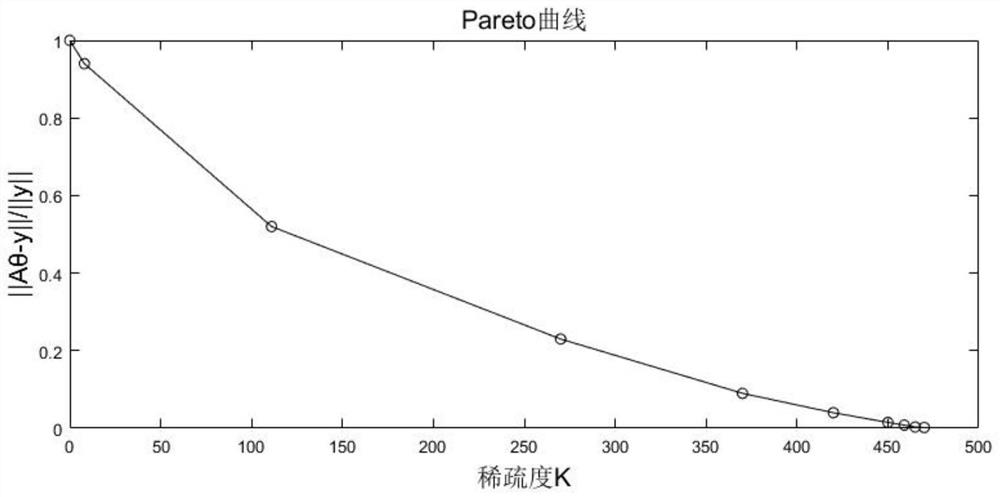Sparsity-adaptive irregular seismic data reconstruction method and system
A technology of seismic data and sparsity, applied in the field of seismic exploration, can solve the problem of low reconstruction accuracy of seismic data, and achieve the effect of solving the problem of low reconstruction accuracy
- Summary
- Abstract
- Description
- Claims
- Application Information
AI Technical Summary
Problems solved by technology
Method used
Image
Examples
Embodiment 1
[0050] Such as figure 1 As shown, the present embodiment provides a sparsely adaptive non-standard seismic data reconstruction method, the method comprising:
[0051] S1, get a perceived matrix, original seismic data, and noise level.
[0052] The seismic data acquisition process based on the compressed perception can generally be expressed as y = aθ, where Y is the sparse seismic wave field data collected, a ∈R M×N In order to perceive the matrix and m << n, θ is a sparse coefficient of the complete seismic wave field in the conversion domain.
[0053] S2, initialization of the first iterative sparseness and the first iterative sparse coefficient. That is, the first iterative sparseness is set to 0, and the first iterative sparse coefficient is set to zero vector.
[0054] S3, according to the sensing matrix, the first iterative sparse coefficient and the original seismic data calculates an error function corresponding to the first iterative sparse coefficient: f (θ 1 ) = || aθ 1...
Embodiment 2
[0089] Such as image 3 As shown, this embodiment provides a sparse-adaptive non-standard seismic data reconstruction system including:
[0090]The data acquisition unit M1 is used to obtain a perceived matrix, the original seismic data, and the noise level;
[0091] The first iteration calculation unit M2 is used for:
[0092] Initialize the first iterative sparseness and the sparse coefficient of the first iteration;
[0093] According to the sensing matrix, the first iterative sparse coefficient and the original seismic data calculate an error function corresponding to the first iterative sparse coefficient;
[0094] The second iterative calculation unit M3 is used for:
[0095] Set the second iterative sparseness to: k 2 = Max (0.001n, 1); where n represents the size of the second dimension of the perceived matrix;
[0096] Using the hard threshold tracking algorithm to solve the second iteration, the constraint function is || θ 2 || 0 ≤ K 2 Where θ 2 Represents the scribble co...
Embodiment 3
[0112] A simple layered speed model is designed in this embodiment, such as Figure 4 As shown, the speed model is positive and the simulation is performed, and the interval of 400 markings, the road spacing is 4m, the time sampling interval 4ms, total acquisition time 1.2s, and the simulated single cannon earthquake record Figure 5 Distance Figure 5 Exemplary shows the original single cannon seismic record. See Image 6 , Image 6 An exemplary showed a single cannon seismic record after randomly extracting 70% seismic road, in this example Figure 5 The single cannon seismic records shown were randomly exhausted and obtained 70% of the single cannon seismic records. See Figure 7 , Figure 7 An exemplary showed a single cannon seismic record after the data reconstruction in the present embodiment, and in the present embodiment Image 6 The sparse single cannon seismic record is reconstructed by seismic data reconstruction using sparse-adaptive compressed sensing seismic data reconstruct...
PUM
 Login to View More
Login to View More Abstract
Description
Claims
Application Information
 Login to View More
Login to View More - R&D
- Intellectual Property
- Life Sciences
- Materials
- Tech Scout
- Unparalleled Data Quality
- Higher Quality Content
- 60% Fewer Hallucinations
Browse by: Latest US Patents, China's latest patents, Technical Efficacy Thesaurus, Application Domain, Technology Topic, Popular Technical Reports.
© 2025 PatSnap. All rights reserved.Legal|Privacy policy|Modern Slavery Act Transparency Statement|Sitemap|About US| Contact US: help@patsnap.com



